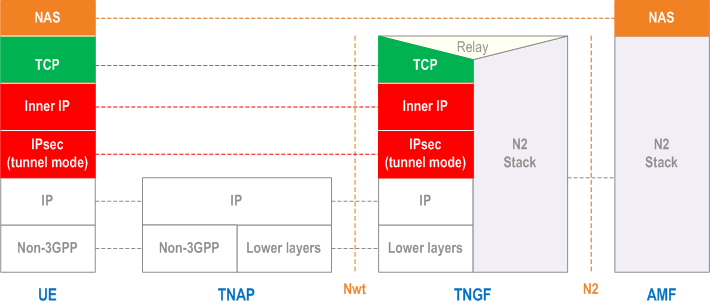Content for TS 23.501 Word version: 19.1.0
1…
3…
4.2.3
4.2.4
4.2.5…
4.2.8…
4.2.8.2.2
4.2.8.2.3…
4.2.8.4…
4.2.9…
4.2.15…
4.3…
4.3.3
4.3.4
4.3.5
4.4…
4.4.6…
4.4.8…
5…
5.3…
5.3.3…
5.4…
5.5…
5.6…
5.6.7…
5.7…
5.7.2…
5.7.3…
5.7.4
5.7.5…
5.8…
5.8.2.11…
5.9…
5.10…
5.11…
5.15…
5.15.11…
5.16…
5.17…
5.18…
5.19…
5.21…
5.22…
5.27…
5.28…
5.29…
5.30…
5.31…
5.32…
5.32.6…
5.33…
5.34…
5.35…
5.38…
5.43…
5.49…
6…
6.3…
6.3.8…
7…
7.2…
8…
8.2.4
8.2.5…
8.3…
A…
D…
E…
F
G…
G.3
G.4…
H…
J
K…
M…
N…
O…
P…
S…
8.2.5 Control Plane for trusted non-3GPP Access
8.2.6 Control Plane for W-5GAN Access
8.2.7 Control Plane for Trusted WLAN Access for N5CW Device
...
...
8.2.5 Control Plane for trusted non-3GPP Access |R16| p. 613


Large NAS messages may be fragmented by the "inner IP" layer or by TCP.

In the above Figure 8.2.5-2 and Figure 8.2.5-3, the UDP protocol may be used between the UE and TNGF to enable NAT traversal for IKEv2 and IPsec traffic.
The NWt connection is defined in clause 4.2.8.3 and in clause 4.12a.2.2 of TS 23.502.
8.2.6 Control Plane for W-5GAN Access |R16| p. 614
The control plane for W-5GAN is defined in clause 6 of TS 23.316.
8.2.7 Control Plane for Trusted WLAN Access for N5CW Device |R17| p. 614

The EAP protocol applies only for performing EAP-based access authentication procedure to connect to a trusted WLAN access network.